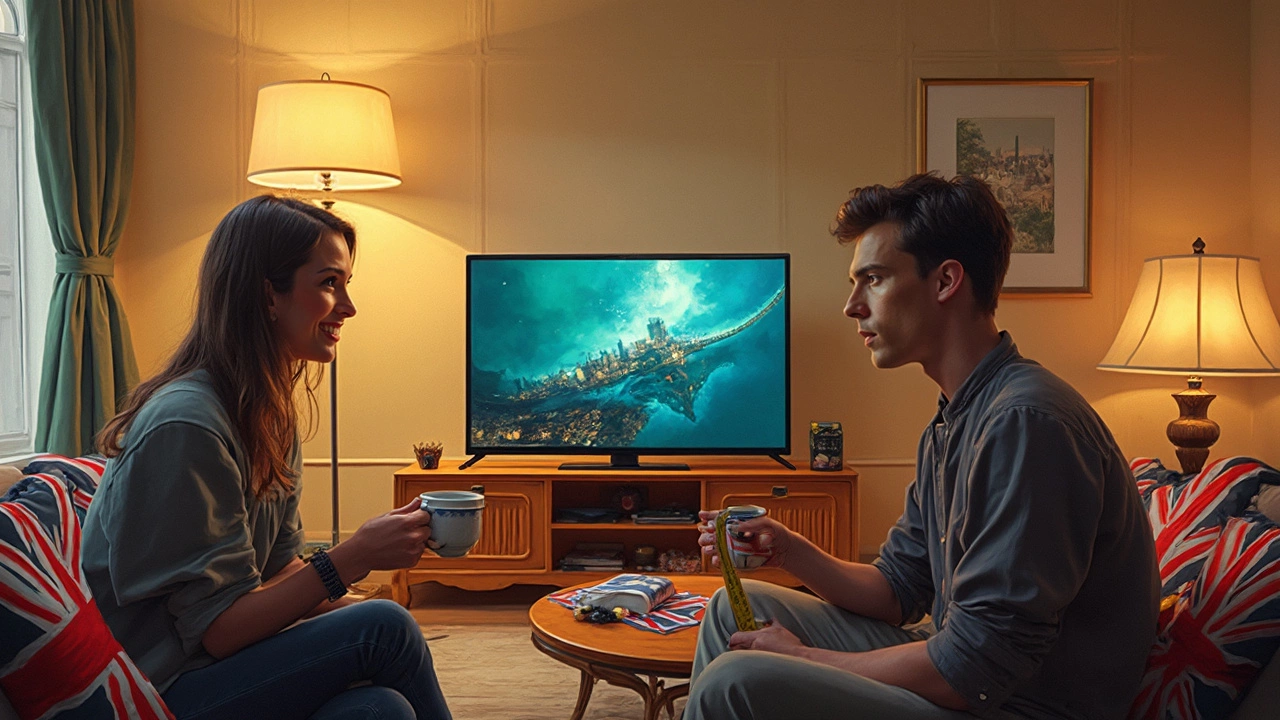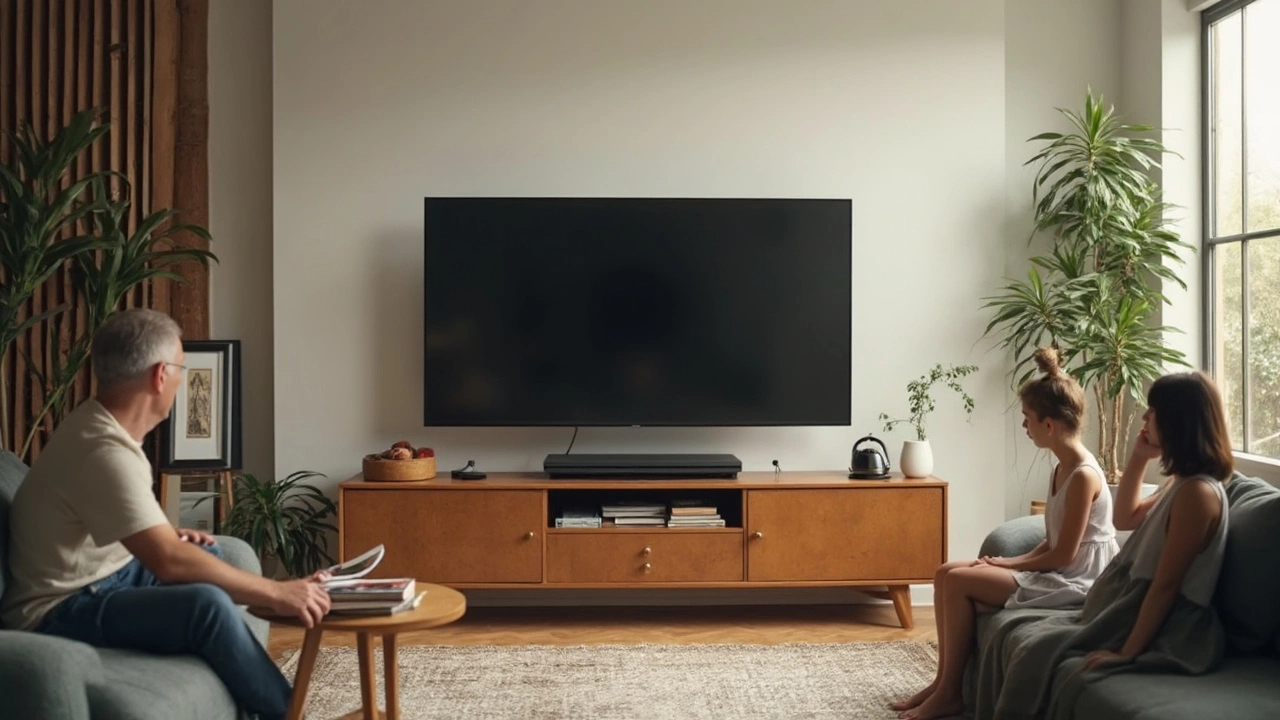Ever seen a TV that looks like it might topple off its stand with one sneeze? That’s not just an eyesore—it’s got people divided. Some folks swear by massive screens that dwarf their stands, while others want neat setups where everything lines up perfectly. But which idea actually makes sense?
Safety First: Why Size (and Stability) Matter
Let’s not play around—safety should be at the top of your checklist when it comes to matching your TV and TV stand. A telly hanging over the edge looks dodgy, but is it really risky? The short answer: absolutely. If your TV is wider than your stand, the ends of the TV are left hanging in the air. That means it’s at greater risk of being knocked, bumped, or outright tumbling to an expensive, tragic end.
Modern TVs are lighter and slimmer than the chunky beasts we had a decade ago, but they’re still pretty fragile. According to the Royal Society for the Prevention of Accidents (RoSPA), emergency departments in the UK see thousands of injuries every year caused by TVs tipping over. It’s not just clumsy adults either—kids and pets are well-known for brushing past the edge, sending screens crashing down. I remember seeing a neighbour’s cat pull off a legendary leap that sent his new OLED flying, and mate, it was panic stations. Getting a bigger TV than your stand turns what should be home entertainment into a slapstick hazard.
The official advice—straight from TV brands like Samsung and LG—states your stand should be at least as wide as your TV, preferably wider. If the stand legs are near the edge, all it takes is a nudge to overbalance. While some people use single-point stands in the centre, these aren’t magic wands. If the stand itself isn’t wide enough to give stability, you’re asking for a headache. The British Standards Institution (BSI) even has a code (BS EN 60065) for stability requirements on audio, video, and similar tech equipment, which is honestly not the kind of bedtime reading you want, but the take-home is simple: don’t overhang your TV off the stand’s edges.
But let’s get real: sometimes the TV’s feet aren’t right at the edges, giving you a few extra centimetres of play. If you’re absolutely determined to stretch your space, check the distance between the TV feet (not just the screen size). Make sure the feet fit securely on the stand and aren’t hanging off. The moment you sacrifice that, you’re betting on luck, not design.
Room Aesthetics: Does Bigger Always Mean Better?
Imagine walking into a mate’s living room where the TV is practically eating the stand underneath it. Impressive cinema vibes? Maybe. But stylish? Not so much. Oversized TVs that hang over their stands can make the whole room feel off. Interior designers nearly always warn about what's called the "top-heavy effect"—your eye goes straight to the wobbly TV, and not in a good way. Your hard-earned cash spent on a top-tier 70-inch telly deserves a setup that shows it off, not makes it look like you made a measuring mistake.
There’s actually some brain science behind this. Studies in environmental psychology show that clutter and lopsided furniture can increase stress and even make a room feel smaller. The TV/stand mismatch adds visual chaos. I’ve chatted with decorators in the Birmingham area who say they always try to balance the scale—if the TV is wider than the stand, it throws out the symmetry people crave in a living space.
But aesthetics don’t mean you have to match things perfectly. Some people want the minimum—just a bit of stand peeking out from beneath, thinking any more is wasted space. Others like a wide unit that echoes the width of the TV and even lets them add speakers, photos, or a stack of dodgy old DVDs to either side. What you want to avoid is the “moustache look”—when a big TV is perched on a dinky, narrow base. It looks uncomfortable, even reckless.
If you fancy a wall-mounted TV, things get a bit easier. Wall-mounting frees you from the tyranny of the measurements, but you’ll still probably want a cabinet or a shelf below. That’s where the scale and balance becomes a design choice, rather than a safety requirement. A 65-inch telly floating over a tiny side table is still going to look weird—no matter the Marvel posters around it. Think about the whole wall composition, not just the TV and stand in isolation.

Practical Considerations: Wires, Accessories, and Real Living
TVs aren’t just screens these days—they’re entertainment hubs loaded with soundbars, gaming consoles, routers, and streaming boxes. If your stand is barely wider than your TV, where does all this kit go? Jamming a PlayStation into the centimetre of space left next to the screen is a recipe for frustration and clutter.
Let’s talk wire management for a second. It’s not the sexiest subject, but those cables do have a way of sprawling if you don’t corral them. A stand that gives you room to tuck away wires, route power leads, and hide extension cords behind closed doors saves your living room from looking like a student flat. And if you’re cleaning, or need to tweak the plugs, a wider stand is way easier to work with. Honestly, if you’ve ever battled in reaching around a too-narrow unit in search of that elusive HDMI port, you’ll appreciate the extra room.
Another thing: ventilation. Consoles and media boxes throw off more heat than you might guess. Cramming them right up against a TV, with nowhere for air to move, is asking for electronics to overheat and pack up sooner than they should. Wide, open shelving supports airflow and gives your investment a longer life.
If your TV stand is narrower than your TV and you want to change, you’ll find loads of options now—open shelves, deep drawers for all those remotes, and stands with built-in cable runs. Shops know TVs are getting bigger, so furniture makers are catching up with styles that don’t dominate your whole wall but still hold the latest screens without stress.
Here's a direct quote from Which?, the respected UK consumer group, that nails the everyday side of things:
‘When choosing a TV stand, make sure your TV’s feet or base fit on it safely, with no overhang. You’ll also want enough space for all your gadgets, and possibly some breathing room for airflow and wires.’
It’s not just a question of making things look neat—practicality stops your evenings from turning into a nightmare of jumbled cables, missing remotes, and overheating electronics. Consider how you live in your room, not just how stuff looks in the catalogue.
What the Pros (and Real People) Recommend
If you ask folks who sell home entertainment gear for a living, they’ll nearly all agree: don’t skimp on the stand. TV manufacturers, electricians, even the bloke in Currys—they’ll tell you the same thing. But there’s a difference between advice you hear in a shop and what actually works in your place.
The rule of thumb? Choose a stand that’s as wide as—or wider than—your TV. This gives you a bit of leeway if you decide to upsize your screen later, or if you want to change your layout. While you might feel tempted to save money or space by squeezing a 60-inch TV on a dainty old IKEA bench, sooner or later you’ll regret it. Especially when you have visitors who notice the telly is hanging off the edge like a tray balancing act. TV size matters, but the setup even more so.
Personal style counts for a lot, too. People with open-plan flats sometimes want everything minimal—no big cabinets. If you’re mounting your TV, invest in a floating shelf or console just below to stash the boxes and remotes. It looks clean, and if you measure carefully, you can get the scale right.
Rental tenants in Birmingham (and it’s the same across the UK) often rely on wall brackets since drilling or buying big furniture is a hassle. If that’s you, just remember to check the mounting weight limits and wall type. No one needs brick dust raining down for the sake of watching Ant and Dec.
Think of your room as a whole. That means pairing the TV with the right-sized stand, making cables disappear, finding places for soundbars, and thinking about how everything looks when you’re sitting on the sofa (with company, a takeaway, or just alone with Netflix and a cup of tea). If you line things up right, you turn watching TV from a risk into a highlight of your home.
To sum up: Go for a stand that matches or beats your TV’s width. Your kit lasts longer, your room feels calmer, and you spend less time worrying about broken screens. Sounds like peace of mind to me.


Write a comment